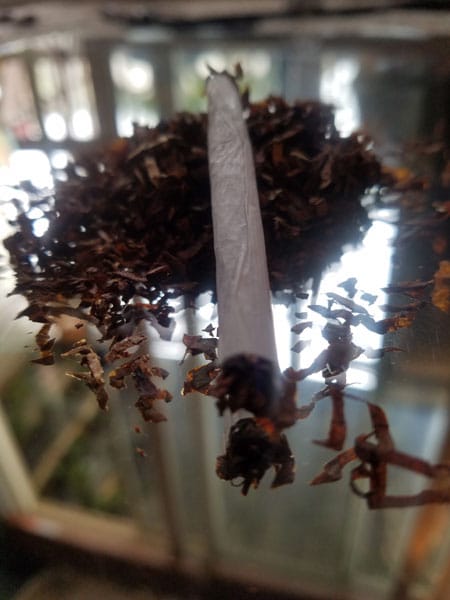Smoke and Mirrors: The Rise of Alt Tobacco
Josh Obzanski is a man of process. The shredder clamped to his coffee table grinds to a close like a pencil sharpener and the shavings of tobacco leaf below lie in a neat, sulfurous pile. “I started with Newports because that’s what I’ve seen everyone smoking,” he said, taking pinches from the pile and sprinkling them into a Tops roller. “But I’ve started buying whole leaf a little over a year ago,” he said. A couple spins of the roller and out pops a cigarette. Josh scrapes a match and takes a puff. “It’s a lot cheaper, buzz is a lot cleaner. You don’t get that chemical aftertaste,” he explains, smoke billowing from his larynx.
But Obzanski isn’t the only one rolling up. Although cigarette use has dropped twelve percent from 2001 to 2014, according to a recent Gallup poll survey, a disheartening discovery was found in the same report. Non-cigarette tobacco use among young adults in each category is almost double that of the national average of 2.3 percent, .8 percent and 3.6 percent for cigars, pipe tobacco and smokeless tobacco respectively. Anti-cigarette initiatives may be pushing young adults into alternative methods of tobacco consumption.
Tobacco in this economy?
But cigarettes are dead, right? Isn’t that what we’ve been told? A 10 percent price increase results in a 4 to 5 percent decrease in cigarette consumption, the Centers for Disease Control and Prevention (CDC) stated. But young adults are two to three times more likely to respond to increases in price than adults, according to the CDC.
So how do the stalwart smokers respond? Turns out, they leverage tax loopholes. In an effort to raise tax revenue and crack down on teen smoking, the Obama administration raised the tax on cigarettes by 156 percent in 2009. However, certain types of cigars as well as pipe and smokeless tobacco were left well enough alone. “There’s often different tax structures by weight or length,” said Timothy Dewhirst, Tobacco Marketing Professor at the University of Guelph. As a result, wide-cut pipe tobacco was taxed at $2.83 per pound while its thinner cousin, cigarette tobacco, weighed in at $24.78 per pound.
The economics are a no brainer for Obzanski, who can roll a pack of cigs for $1.50 instead of dishing out the national average of $6.28 at the convenience store, according to the CDC. Price is the main concern for actor Max Turner as well, based out of New York City, home of the highest cigarette tax in the country. A pack of factory made cigarettes will set you back $12.85 in the big apple, according to a survey by theawl.com.
A smorgasbord of nicotine
 These smokers know the economic cost, so why do they start? As always, the seed of tobacco dependence is planted in social interaction. “You’re just trying to mingle, you try it and suddenly you’re addicted,” Turner said. For him, it becomes a part of your life. From hanging with friends to breaks at work, you develop a routine that’s hard to divorce. “By the time people realize ‘oh wow, I’m smoking a lot more than I use to,’ you might very well have become addicted,” the Truth Initiative’s CEO Robin Koval said.
These smokers know the economic cost, so why do they start? As always, the seed of tobacco dependence is planted in social interaction. “You’re just trying to mingle, you try it and suddenly you’re addicted,” Turner said. For him, it becomes a part of your life. From hanging with friends to breaks at work, you develop a routine that’s hard to divorce. “By the time people realize ‘oh wow, I’m smoking a lot more than I use to,’ you might very well have become addicted,” the Truth Initiative’s CEO Robin Koval said.
But now the avenues to tobacco introduction have exploded, and young smokers have a buffet of nicotine delivery to choose from. From hookah and flavored cigarillos to e-cigarettes, the world of tobacco culture has been revitalized. New smokers have the opportunity to experiment and it shows. The use of three or more methods of tobacco consumption for young adults is double the national average, according to a Gallup poll.
There can be drawbacks however. Setting up a hookah is a process and doesn’t lend itself to mobility while lighter-taxed large cigars can take up to an hour and a half to smoke. The amount of nicotine inhaled per session is also much larger. A cigar can contain as much nicotine as a pack of cigarettes, the CDC found. But hookah is much worse. “People think that because you smoke a water pipe and it comes in lots of flavors that it’s safe. They have no idea that a one hour hookah session is the equivalent to smoking 5 packs of cigarettes,” Koval said.
The tobacco overload can be overwhelming for smokers like Obzanski. “I don’t smoke much hookah or cigars anymore. It was more of a passing phase in high school,” he said. Those looking for economy, convenience and portion control usually end up with e-cigarettes and hand-rolled pipe tobacco in hand.
Smoking Under False Pretenses
Aside from addiction and tax-loopholes, there is another perceived benefit to buying your own tobacco that may be coat-tailing the organic movement. “Additive free” has become somewhat of a calling card for young smokers. Obzanski has gone as far as buying whole, uncut leaves of the plant to avoid the chemicals involved in cigarette processing. “I’d rather be smoking pure tobacco than something with all the additives in it,” he said. Turner recognizes the hazard in tobacco itself but is more concerned with the wrapping. “In some ways it’s not much better, but it doesn’t contain the massive amount of chemicals that are in the paper,” he said.
However, the “organic” label can be misleading when applied to products like tobacco. They can lead to false ideas about the safety of their cigarettes and obscure risk management. No difference in exposure to carcinogens was found between roll-your-own, and factory-made cigarettes according to a University College London study.
These perceptions stem from the marketing of the products themselves. “A concern is that with a lot of other tobacco forms, the warning is not as prominent with the packaging which might influence perception of health effects,” Dewhirst said. He continued to explain that young adults and millennials are also being targeted more aggressively now than in the past because that demographic has the highest percentage of sustained smokers. “We see an ‘ageing-up’ of initiation,” Koval said. “The tobacco industry has figured out that we kicked them out of the middle schools and a lot of places where they typically would have recruited their replacement smokers,” she continued.
A matter of image
But these smokers are still of a more informed era. “There is no safe level of smoking,” Koval said but by now, eighty percent know the risks, Gallup found. There’s a quality and self-image of the hand-roller involved. “I just prefer the taste of the tobacco I roll. It suits me more as a person,” Turner said. So, like alcohol, it’s become a more calculated risk. “I’m sure the stress and addiction are there, but ultimately I just enjoy smoking,” Obzanski said.









